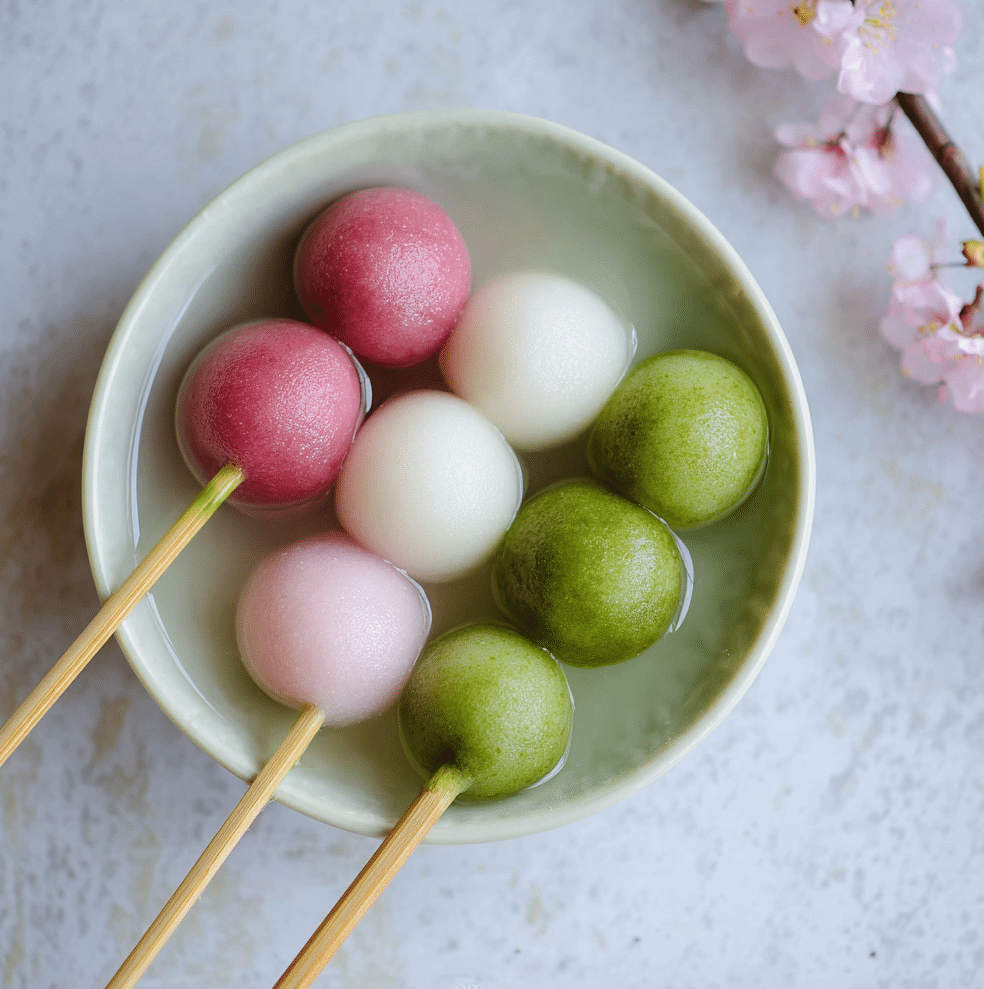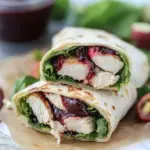The delicate and colorful Hanami Dango is a traditional Japanese treat most often enjoyed during cherry blossom viewing season, or Hanami. Its three pastel-colored rice dumplings on a skewer — green, white, and pink — are not only a treat for the taste buds but also a visual celebration of spring. Each color represents the seasonal change: green for new growth, white for the lingering winter, and pink for the blooming sakura.
This sweet rice dumpling is naturally gluten-free, delightfully chewy, and lightly sweet. Hanami Dango is fun and simple to make, whether you’re looking to honor a cultural tradition or try something new in your kitchen. It’s perfect as a snack, a dessert, or a centerpiece at a spring-themed gathering. Best enjoyed fresh, this elegant and symbolic dish truly brings the spirit of Japanese festivals into your home.
Full Recipe
Ingredients:
-
1 cup glutinous rice flour (mochiko)
-
1/4 cup sugar
-
1/2 cup water (plus more as needed)
-
Red food coloring (or natural beet juice)
-
Matcha green tea powder (or green food coloring)
-
Bamboo skewers
Directions:
-
In a large mixing bowl, combine glutinous rice flour and sugar. Gradually stir in the water until a smooth dough forms. If it feels dry, add a teaspoon of water at a time.
-
Divide the dough into three equal parts. Leave one plain (white), mix one part with a small amount of red food coloring to create pink dough, and mix the third with matcha powder to create green dough.
-
Roll each colored dough into small balls, about the size of a marble. Aim for 8-9 balls per color.
-
Bring a pot of water to a boil. Carefully drop in the balls (one color at a time for easier tracking). Boil until they float to the top, then continue cooking for an additional 1-2 minutes.
-
Using a slotted spoon, transfer the cooked dango to a bowl of ice water to cool.
-
Once cooled, drain and thread 3 balls (green, white, then pink from top to bottom) onto bamboo skewers.
-
Serve fresh or cover lightly with plastic wrap to keep moist until serving. Best eaten the same day.
Prep Time: 20 minutes | Cooking Time: 10 minutes | Total Time: 30 minutes
Kcal: 140 kcal | Servings: 6 skewers
What is Hanami Dango?
Hanami Dango is a traditional Japanese sweet treat commonly enjoyed during hanami, the cherry blossom viewing season in Japan. It consists of three small, chewy rice flour dumplings skewered on a bamboo stick, typically colored green, white, and pink from bottom to top. While dango (Japanese dumplings) are enjoyed year-round in various forms, Hanami Dango is unique for its visual appeal and cultural symbolism tied to spring and renewal.
The word “Hanami” translates to “flower viewing,” which refers specifically to the act of admiring cherry blossoms, or sakura. These blossoms only last a short time, making their arrival a significant, almost spiritual event. As people gather under blooming cherry trees with picnics and seasonal treats, Hanami Dango stands out as a colorful and culturally rich snack.
Historical Background
Dango has roots going back centuries in Japanese cuisine. Originating as a simple rice dumpling offered at shrines and temples, it evolved over time into a more varied and flavorful treat. By the Edo period (1603–1868), sweetened dango varieties were commonplace, and food vendors began selling seasonal dango as part of temple fairs and festivals.
Hanami Dango in particular became closely tied to cherry blossom festivals during this period. As the practice of hanami spread among the aristocracy and then to the general population, specialized foods like these colorful dumplings became symbolic of the celebration. The trio of colored dumplings was likely inspired by traditional Japanese aesthetics and the appreciation of transience, a theme closely tied to the cherry blossom itself.
Symbolism of the Colors
Each color in Hanami Dango carries a specific meaning that connects to both the seasons and Japanese cultural beliefs:
-
Green symbolizes new growth and the promise of spring. It’s often flavored or colored using matcha (green tea powder), which adds a slightly earthy undertone.
-
White represents the lingering winter, offering balance and simplicity. It’s the neutral center that connects past and present.
-
Pink reflects the blooming cherry blossoms, the heart of the hanami celebration. This color is associated with love, beauty, and the fleeting nature of life.
Together, the colors reflect Japan’s deep appreciation of nature, seasonal cycles, and the balance between past and future.
Texture and Flavor Profile
Hanami Dango has a delightfully chewy, mochi-like texture owing to its use of glutinous rice flour (mochiko). It’s subtly sweet, often enhanced with a hint of sugar, though not overwhelmingly so. The dumplings don’t usually have a filling, keeping the focus on their texture and aesthetic.
While traditional Hanami Dango is not strongly flavored, modern variations may use natural additives like beet juice, sakura essence, or matcha powder to enhance both the color and taste. This gives each skewer a delicate balance of earthy, floral, and sweet flavors, making it appealing even to those unfamiliar with Japanese confections.
Cultural Importance During Hanami
The hanami tradition is deeply woven into the fabric of Japanese life. During spring, families, friends, and co-workers gather beneath cherry blossom trees in parks, gardens, and riversides. They spread out blue tarps, share bento boxes, drink sake, and enjoy seasonal sweets like Hanami Dango.
These gatherings are more than just picnics—they’re a celebration of life’s impermanence. The cherry blossom, which blooms and falls in just a couple of weeks, is seen as a metaphor for the fleeting beauty of existence. In this setting, Hanami Dango isn’t just food; it’s part of a cultural ritual, a small edible tribute to nature’s poetry.
Eating Hanami Dango under the cherry blossoms completes the hanami experience, making it a highly anticipated seasonal ritual for many people in Japan.
Modern Popularity and Global Appeal
As Japanese cuisine continues to gain global popularity, so too has interest in traditional confections like dango. Thanks to platforms like Instagram and TikTok, where visuals play a key role, Hanami Dango has found a new international audience that appreciates its vibrant colors and charming presentation.
Beyond aesthetics, there’s growing interest in gluten-free and plant-based desserts, and Hanami Dango fits into these trends naturally. Since the main ingredient is glutinous rice flour, it contains no gluten. It’s also vegan, as it typically does not contain dairy or eggs.
Chefs and food bloggers around the world now experiment with Hanami Dango by using fruit purées, herbal infusions, or creative colorings to give it a modern twist, all while honoring its traditional roots.
Tips for Making Hanami Dango at Home
Even though Hanami Dango looks elegant and delicate, it’s surprisingly easy to make. The process involves making dough with glutinous rice flour, dividing and coloring the dough, boiling the dumplings, and then assembling them on skewers.
For coloring, many prefer using natural ingredients such as:
-
Matcha powder for green
-
Beet juice or strawberry purée for pink
-
Plain dough for white
The most important tip is to get the texture right. The dough should be smooth, pliable, and not too sticky. Boiling the dumplings until they float and then transferring them to ice water helps set their chewy texture and makes them easier to skewer.
When and How to Serve
Hanami Dango is best served fresh and slightly chilled. You can present them on bamboo skewers for a traditional look or place them individually on a plate for a modern twist. They’re perfect for afternoon tea, spring parties, or as a fun hands-on activity with kids.
They also make charming edible gifts. You can wrap them in wax paper, tie them with a string, and offer them as seasonal treats during cherry blossom-themed events.
Pairing Hanami Dango with green tea, especially matcha, enhances its subtle sweetness and elevates the experience. The slight bitterness of the tea balances the soft sugar notes of the dango, providing a refreshing contrast.
Health Benefits and Dietary Considerations
Hanami Dango is a relatively light and healthy dessert, especially when compared to heavier Western pastries or cakes. The portion size is small, the sweetness is mild, and it uses few ingredients.
Because it is made with glutinous rice flour, it’s naturally gluten-free, making it accessible for those with gluten intolerance or celiac disease. It also does not require dairy or eggs, which makes it ideal for vegan or dairy-free diets.
However, because it is made of rice flour and sugar, it’s still high in simple carbohydrates, so it’s best enjoyed in moderation—especially by those watching their blood sugar levels.
A Treat with Cultural and Emotional Resonance
One of the most beautiful aspects of Hanami Dango is how it connects people to the seasons, to their cultural roots, and to one another. Making or sharing these pastel skewers is more than just eating—it’s an expression of seasonal appreciation, artistry, and mindfulness.
In Japan, even convenience stores begin to sell beautifully packaged Hanami Dango as cherry blossom season approaches. Its presence signals that winter is behind, and that spring—with all its promise—is here. Whether you’re walking under a canopy of blooming sakura or simply enjoying them from your window, Hanami Dango brings a taste of that magical transition right into your hands.
Conclusion
Hanami Dango is far more than a sweet rice dumpling—it is a vibrant cultural symbol of Japan’s hanami tradition. With its trio of pastel colors and chewy, mochi-like texture, it delights both the eyes and the palate. Whether enjoyed under blooming cherry blossoms in Tokyo or in a cozy kitchen halfway across the world, this treat captures the spirit of renewal, appreciation for nature, and the fleeting beauty of life.
As modern home cooks continue to explore global cuisines, Hanami Dango stands out as a perfect combination of ease, elegance, and deep cultural meaning. It invites people not only to savor a unique dessert but also to embrace the rituals that make food so deeply human. If you’re looking to add beauty and purpose to your spring celebrations, Hanami Dango is the perfect place to start.






